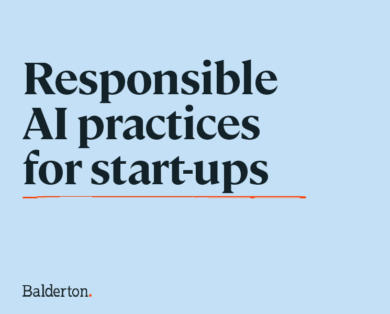- 20 November, 2024
Since Balderton announced Europe’s first “secondary” venture fund at the end of last year — Liquidity I — I have spent the last five months talking to many of Europe’s fastest scaling, growth-stage tech startups. Here’s what I’ve heard.
There is no doubt we are entering the most exciting time for European venture yet. With every conversation, our conviction about the incredible potential of European tech startups has continued to grow. The European venture ecosystem has undergone dramatic growth over the last 10 years.
All over Europe, the number of European startups getting to scale has swollen in line with the global ambitions of Europe’s tech entrepreneurs, the quality of European tech talent and, critically, the availability of funding to fuel that growth.
But I’ve also heard the following confirmed: these exciting times bring the challenges of a maturing ecosystem. As the amount of capital invested in European venture grows and the equity value of the fastest-growing European startups continues to rise, the absence of a structured route to liquidity for early shareholders is becoming increasingly problematic.
The Liquidity Gap
Why, and for whom, is the Liquidity Gap a problem?
To answer this, we need to look at the three key stakeholders in this story. These include early-stage investors, early-stage employees, and founders, as well as a critical third stakeholder: the ecosystem at large.
For early investors — there may be a need to crystallise early gains.
For early employees and founder shareholders — personal financial situations may change. For example, exiting founders may want to pursue new ventures and reinvest their proceeds.
For both these stakeholders, over time, this liquidity gap can become a source of significant shareholder tension and management distraction — distraction and tension that only grows as the financial needs increase and can lead to suboptimal exits for all parties involved.
But there’s also an impact on the ecosystem more broadly. Much of the capital that would otherwise be recycled into new ventures, creating a virtuous cycle for the ecosystem, stays locked up for longer than necessary or leaks out through inefficient and expensive secondary transactions, acting as a constraint on the ecosystem.
There has historically been some secondary liquidity of course. For breakout names like Spotify, we saw highly liquid markets develop, and existing investors also provide some liquidity at times. But for the majority of later-stage European startups, liquidity has been sparse while latent demand for it has grown. At the time of our launch, the total value of early-stage capital (rounds below $10m) invested in Europe since 2008 was around $23bn, of which $10bn was raised over 5 years ago and remains locked in.
We launched the Liquidity I fund with a view to addressing this pain point. Though it is still early days, the tremendous response we have had since our launch has confirmed our thesis about the size of the opportunity.
But while liquidity is an important tool for the ecosystem, there need to be sensible parameters around providing it. Below I go into a bit more detail about how we think about the role of liquidity in the ecosystem and key considerations for management.
The Hard Conversations
Having the hard conversations: when founder and employee liquidity becomes a sensitive topic
Most investors these days recognise the importance of letting management and employees take partial liquidity at the growth stage. However, while the total absence of liquidity can damage the ecosystem, too much liquidity can be counterproductive.
Why is this?
Equity provides both pure upside participation for investors and participation-as-an-incentive for employees and founders, aka skin in the game. Clearly, that’s true of both public and private markets. However, in startups, equity tends to be a much larger component of all employees’ compensation. Startups typically offer a base pay scale below that of public companies. Talent stays loyal because of the potential of equity gains — the machine that has fuelled Silicon Valley talent for thirty years. If the company is ‘successful’ (that is, some exit occurs), most, if not all, of the employee’s wealth will come as a result of sticking with the company over the long haul.
Combine the structure of equity compensation in the tech ecosystem with the standard risk and return profile of venture investing and you get a maxim that underscores investor sensitivity around secondary transactions: employee and founder skin in the game maintains symmetry (or reciprocity) in a market with significant asymmetry in information and outcomes.
As such, there are additional considerations around the provision of liquidity in venture.
(i) Asymmetry in venture: dispersion in early-stage returns, information asymmetry and negative signalling
Returns in early investing can be best described by a Power Law distribution, that is the majority of returns are made by a small number of portfolio investments. In addition to this, early-stage VCs often invest in businesses characterised by high information asymmetry: the best investors will be intimately familiar with the space they have invested in and have significant operational and financial know-how, but nothing substitutes for the information you get being in the business day to day.
The more disruptive and fast moving a startup is, the more investors pay attention to signals made by the startup about its probability of success, in addition to the other information being provided directly. This is equally important for employees who know that a large part of their compensation package has a very low probability of being valuable and a very high probability of being worth nothing at all. All shareholders watch management signals avidly.
Why do we care?
In the absence of contextual information, shareholders will usually settle for the simplest interpretation of a signal (that’s the thing about signalling) and take management desire to do a large secondary sale as an expression of doubt about the viability of their projections, a lack of commitment to their vision or a high internal discount rate. None of these are good from an investor perspective.
This can become hugely problematic for a high-performing startup and all shareholders, in the context of future rounds and indeed for the secondary transaction itself. Great teams can find themselves in an unnecessarily difficult situation. We have walked away from several high quality businesses because we could not reconcile the amount of secondary being asked for with management conviction – a logic which most investors abide by.
As discussed, there are often entirely valid reasons for secondary liquidity. So how can management solve for this negative signalling? By framing the discussion very carefully. That means being thoughtful about (i) the timing, and (ii) the amount of secondary while (iii) being as communicative as possible with current shareholders. The earlier the sale and the larger the quantum, the greater the likelihood this is a negative signal and will rightly be interpreted as such.
The sensitivity investors show about secondary isn’t just to do with signalling about the current performance of the business, it’s also to do with the role equity plays in startups over time.
(ii) Restoring symmetry and the principle of reciprocity: skin in the game as a guard against adverse incentives and moral hazard
The principle of equity funding in venture is predicated on great teams sharing some of the value they create with investors, in exchange for investors taking on significant financing risk. Equity compensation and “skin in the game” enshrines the principle of reciprocity between investor and founder and can guard against adverse incentives and certain negative outcomes. In the startup world, having unrealised equity gains is an important safety valve both investors and founders use to keep teams hungry, either by technically limiting the risk of moral hazard (founders increasing their risk unacceptably when liquidity acts as a financial insurance policy), disincentivizing the entrance of bad actors (venture as the ultimate Ponzi scheme with teams raising ever larger rounds and cashing out) or, more benignly, correlating effort to reward.
Given the dynamics described above, excessive and poorly timed liquidity can create as many complications and adverse incentives as pain points it solves. Hence investors usually set parameters around the acceptable secondary amount for founders and the stage at which it should be considered. As a good rule of thumb, we would not expect a founder to sell more than 10% of their overall holding at the growth stage.
Loss aversion
Is there such a thing as having “too much” skin in the game?
Loss aversion refers to the fact that most people prefer to avoid losses than acquire equivalent gains, i.e. better not to lose $100 than to find $100. As startups grow and more of a founder and management’s wealth is tied up in equity, with less certainty about their gains than potential losses, this can paradoxically lead them to minimise risk-taking, i.e. risk appetites are not static and evolve as the size of the potential loss grows.
Paradoxically, one of the very mechanisms which can drive a business to succeed in the first place can become psychologically distortive over time. A diversified VC who might have 20+ investments in their portfolio relies on management teams in each of these having continued high-risk tolerance and growth appetites.
As such, partial liquidity can be extremely helpful in keeping founders and investors aligned.
Solving the liquidity gap
Addressing the liquidity gap is an essential building block for the European ecosystem.
But while the liquidity gap acts as a constraint on European tech, too much liquidity can create adverse incentives. There are often good and essential reasons for secondary transactions but key shareholders looking to sell need to be careful about framing a secondary discussion intelligently to avoid negative signalling.
The partial liquidity our fund provides aims to strike a sensible balance between releasing some of the financial pressure early shareholders can experience and keeping stakeholder incentives aligned. In Part 2, “Six key questions for management,’ we provide a quick guide for how to think about timing, structuring and executing a secondary transaction.
Footnote: A note on selling restrictions
Depending on the jurisdiction, a secondary transaction can trigger a valuation event with major implications for both tax and the cost of equity compensation going forward. In the US for instance, there are several factors that inform the impact of a secondary transaction given section 409A of the Internal Revenue Code.
 LAURA CONNELL
LAURA CONNELL 












